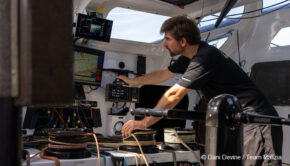Changing the trajectory of yachting
Published on April 8th, 2020
As design development for the America’s Cup continues to push the boundaries of technology, requiring more computer skill and less sailor skill, why should powerboaters miss out on these advancements? Because really, learning how to do stuff is so yesterday.
If you are curious about the future, Scuttlebutt HQ received notice from DLBA Naval Architects on how they view it.
With the rapid advancement of artificial intelligence (AI), the potential for impressive and boundary-pushing progress across all aspects in yachting is at our fingertips. Advancements in automation of vessel machinery, electrical, and navigation systems has an immense potential to improve the yachting experience for all owners.
With the immense potential for revolution comes the need for extensive design, engineering, and testing. DLBA Naval Architects is developing a 58m concept superyacht, which thinks through all vessel systems to see where artificial intelligence can take the superyacht experience to the next level.
DLBA has selected a 58m superyacht concept to develop internally as an autonomous yacht. The result, TEMPO, will be a study in all vessel systems where artificial intelligence can be used to enhance an owner’s experience onboard.
The name of the concept is tied to the uptick in operational tempo that the AI will make possible through enhanced reliability and operational availability, meaning that owners and guest will be able to spend more quality time onboard enjoying all that yachting can offer.
There are three main areas where autonomous technology can be brought to bear in the maritime world – navigational autonomy, equipment health monitoring, and mechanical and electrical systems automation.
DLBA’s vision is to deliver best-in-class autonomous vessels as the industry-leading vessel designer and autonomy integrator, and it’s expected that, through this process, questions which are already being raised on autonomy will be answered to move this field forward.
The company’s prior experience with autonomous vessel research and development programs means it’s well-placed to understand the challenges and limitations of this field and has seen it partner with traditional and non-traditional technology providers to push automation for the best results.
This allows the company agility as it integrates continually-evolving autonomous technology into the concept yacht, the exterior design of which was provided by SDG; and it’s looking forward to working with visionary vessel owners seeking to benefit from autonomy themselves.










 We’ll keep your information safe.
We’ll keep your information safe.